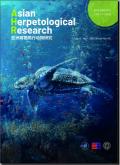不同体型和生境的三种沙蜥的热偏好和耐受性差异
IF 1.2
3区 生物学
Q2 ZOOLOGY
引用次数: 13
摘要
本研究将两种胎生鬣蜥(Phrynocephalus guinanensis和P. vlangalii)和一种胎生鬣蜥(Agamidae)的成虫分别驯化在28°C、33°C和38°C环境中,以研究其热偏好(偏好体温,Tp)和热耐受性(临界最低热值,CTMin);临界热最大值(CTMax)受驯化温度的影响,并与体型和生境利用相关。Tp和CTMax均以花椒最高,花椒最低,桂花椒居中。两种胎生种的CTMin和耐热范围没有差异,均比胎生种更耐低温,耐热范围更广。CTMin和CTMax均随驯化温度的升高而升高。Tp在33°C环境中的含量高于28°C和38°C环境中的含量。适应28℃的蜥蜴的热耐受范围比适应33℃和38℃的蜥蜴更宽。结果表明:1)热偏好和耐热性受驯化温度的影响,且不同体型和生境的三种蜥类的热偏好和耐热性存在差异;2) Tp和CTMax在与环境换热较快的物种中较高,CTMin在活动季节处于较温暖生境的物种中较高;3)热偏好和热耐受性可能与体型和生境利用有关。本文章由计算机程序翻译,如有差异,请以英文原文为准。
Differences in Thermal Preference and Tolerance among Three Phrynocephalus Lizards (Agamidae) with Different Body Sizes and Habitat Use
We acclimated adults of two viviparous (Phrynocephalus guinanensis and P. vlangalii) and one oviparous (P. versicolor) species of toad-headed lizards (Agamidae) to 28 °C, 33 °C and 38 °C to examine whether thermal preference (preferred body temperature, Tp) and thermal tolerance (critical thermal minimum, CTMin; critical thermal maximum, CTMax) were affected by acclimation temperature, and correlate with body size and habitat use. Both Tp and CTMax were highest in P. versicolor and lowest in P. vlangalii, with P. guinanensis in between. The two viviparous species did not differ in CTMin and thermal tolerance range, and they both were more resistant to low temperatures and had a wider range of thermal tolerance than the oviparous species. Both CTMin and CTMax shifted upward as acclimation temperature increased in all the three species. Tp was higher in the lizards acclimated to 33 °C than in those to 28 °C or 38 °C. The range of thermal tolerance was wider in the lizards acclimated to 28 °C than in those to 33 °C or 38 °C. The data showed that: 1) thermal preference and tolerance were affected by acclimation temperature, and differed among the three species of Phrynocephalus lizards with different body sizes and habitat uses; 2) both Tp and CTMax were higher in the species exchanging heat more rapidly with the environment, and CTMin was higher in the species using warmer habitats during the active season; and 3) thermal preference and tolerance might correlat with body size and habitat use in Phrynocephalus lizards.
求助全文
通过发布文献求助,成功后即可免费获取论文全文。
去求助
来源期刊

Asian Herpetological Research
ZOOLOGY-
CiteScore
2.80
自引率
7.10%
发文量
441
审稿时长
>12 weeks
期刊介绍:
AHR aims to provide a forum for herpetologists and related scientists interested in conducting international academic exchanges and joint studies, and a platform for introducing their newly made scientific and technological data, and publishing their research results and achievements in the world, but focusing on the Asian-Pacific Region.
The principal criteria of AHR for acceptance of articles for publication are the quality and significance of the research, breadth of interest of the work to the readership, and the clarity and effectiveness of communication. AHR welcomes submission of manuscripts from authors in all countries of the world, though with a focus on the herpetological studies in the Asian and Pacific Region, including major articles, shorter communications and review articles.
 求助内容:
求助内容: 应助结果提醒方式:
应助结果提醒方式:


